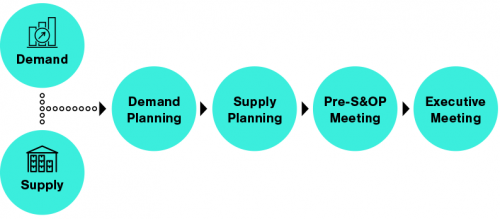
Advancing beyond S&OP: Is IBP the right approach for you?
As businesses mature and markets fluctuate, the need for adaptable planning processes increases. Transitioning from…

Sales & Operation Planning (S&OP) creates a consensus-based business plan that facilitates corporations to handle inventory costs while significantly improving service levels. S&OP coordinates different business areas to meet customer demand with the appropriate level of supply.
It is a monthly business management process that allows experts to focus on core Supply Chain drivers encompassing marketing, production, inventory management, sales, and demand management. It joins forces to generate a single production/supply plan. The far-reaching goal is to line up future company strategy with functional capability.
Initially identify the roles and responsibilities of each individual/team in the S&OP process.
When setting up your strategy, it is essential to ponder who will control each stage—set opportunities for meetings, hand-offs, and how you will communicate changes; the input determines the effectiveness of the S&OP planning. To advance with a monthly S&OP plan, you must establish that minimal significant modifications can be added to the demand plan within the month.
Outline functions, responsibilities, and timing of each step after the end of each month. The actions and responsibilities can then be introduced into a collective plan with reminders, meetings, and attendee’s scheduled responsibilities.

This phase demands data on trend analysis, past sales, and forecast accuracy assessments of forecast accuracy. Advanced S&OP planning software can supervise several tasks through developing automated data and built-in reports. The Demand Planner usually is accountable for leading this phase in the process. Principal contributions for this phase will come from sales and marketing, and you should consider the information previously supplied from operations/supply and logistics.
Supply planning encompasses translating the demand plan into an appropriate supply plan. Its tasks are determining inventory targets, production methods for safety stock levels, and demand track. It also involves assessing the ability to meet demand by reviewing available capacity, inventory, and operations scheduling.
The Head of Supply will be accountable for creating the Supply Plan. For input and authentication, check with the strategic team from finance, manufacturing, operations, logistics.
The S&OP leader is typically responsible for the efficient execution of this meeting. Essential partakers incorporate Marketing, Sales, Operations, and Logistics (including finance).
Resolving if the sales plan adjusts inventory and backlog objectives demands classifying through supply-side issues to determine if the sales plan can be modified, inventory and backlog purposes can be met. This step happens during the monthly pre-S&OP meeting. Additional tasks include evaluating supply performance from the earlier month and submitting forecasts.
Once the demand and supply plans are settled, planners communicate the result to the decision-making team in the monthly Executive S&OP meeting. The meeting results are an agreed demand and supply plan that the company can effectively implement.
The S&OP leader will supervise this meeting/step in the process, but the Executive Sponsor is a vital partaker and will be needed to conclude all decisions/outcomes of the meeting.
Executive management: The CEO/Leader is the principal connection for dispute resolution throughout the S&OP process:
Marketing and Sales leaders: It is the central contact for issues associated with strategic sales/customer decisions:
Demand planning: Is the contact for issues related to the development of sales, analysis of forecasts, and progress of final demand planning:
Sales personnel: Each account manager is the key contact for issues related to sales forecasts for customers and segments and assists in gathering data from designated customers and incorporating outcomes into the demand plan:
Operation leader: Is the principal advocate for issues correlated to strategic operations/supply decisions:
Supply planning and master scheduling: The principal contacts for issues attached to orders, inventory, and the supply planning process:
S&OP drives enormous benefits to lower inventory expenses, higher efficiency, and better customer satisfaction. Top Supply Chain planning solutions further enhance benefits by facilitating the S&OP plan to drive requirements and move from planning to implementation.
Navigate complex challenges and market volatility with confidence